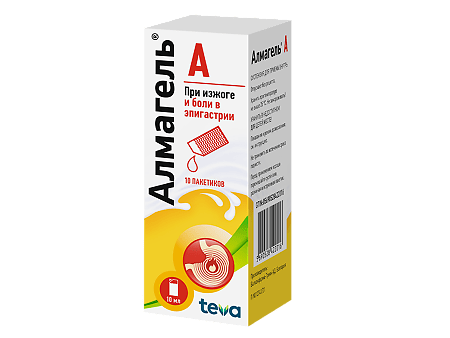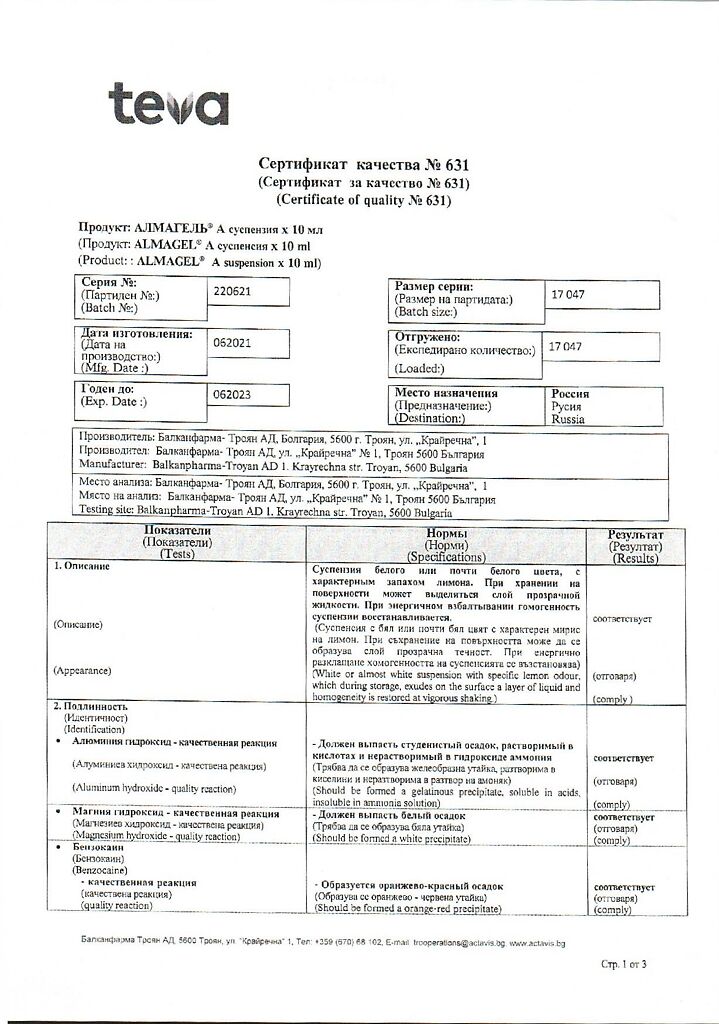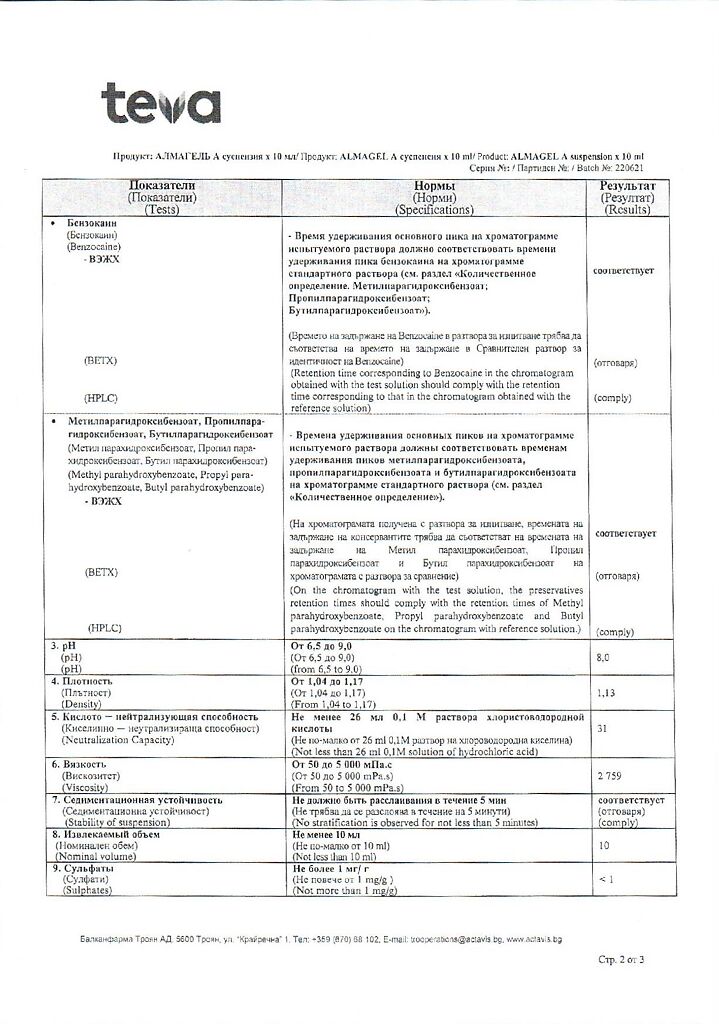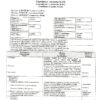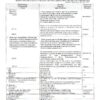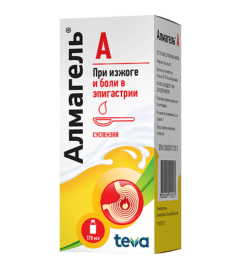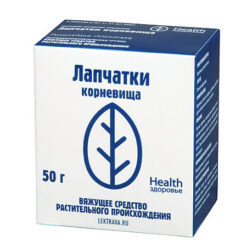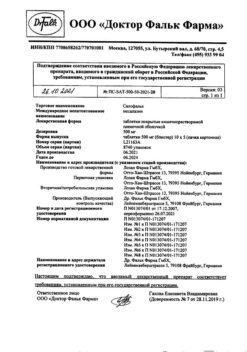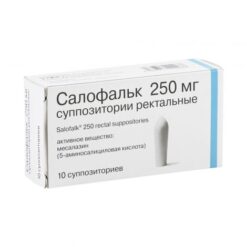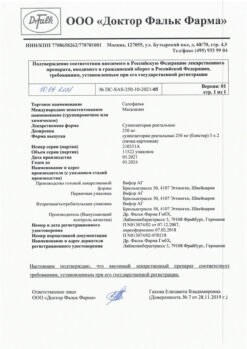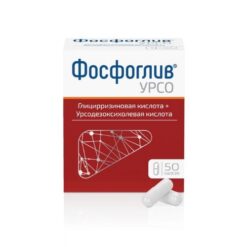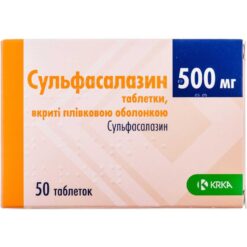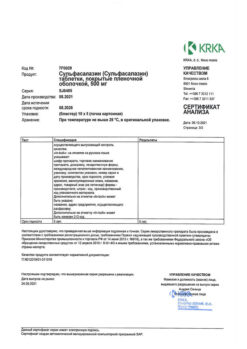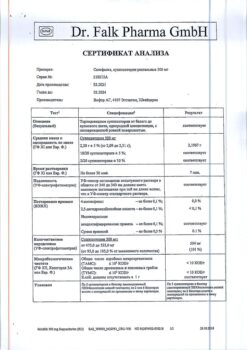No products in the cart.
Almagel A, 10 ml suspension 10 pcs
€13.15 €11.29
EAN: 5690528422016
SKU: 294109
Categories: Medicine, Stomach, intestines, liver, Ulcer and gastritis
Description
Pharmacotherapeutic group
Antacid + local anesthetic
ATX code: A02AB10
Pharmacological properties
.Pharmacodynamics
Almagel® A is a drug that is a balanced combination of algeldrate (aluminum hydroxide), magnesium hydroxide and benzocaine. Almagel® A neutralizes free hydrochloric acid in the stomach, reduces the activity of pepsin, which leads to a decrease in the digestive activity of gastric juice. It has a coating and adsorptive effect. It protects the mucous membrane of the stomach by stimulating the synthesis of prostaglandins (cytoprotective effect). This protects the mucous membrane from inflammatory and erosive-hemorrhagic lesions due to irritating and ulcerogenic agents such as ethyl alcohol and nonsteroidal anti-inflammatory drugs (e.g., indomethacin, diclofenac, aspirin, acetylsalicylic acid, corticosteroid drugs). The therapeutic effect after taking the drug comes in 3-5 minutes. The duration of action depends on the rate of gastric emptying. When taken on an empty stomach, the action lasts up to 60 minutes. When taken one hour after a meal, the antacid action may last up to 3 hours.
Does not cause secondary hypersecretion of gastric juice.
Benzocaine has a local analgesic effect in the presence of severe pain syndrome.
Pharmacokinetics
Algeldrate
absorption –small amounts of the drug are resorbed with little or no change in the concentration of aluminum salts in the blood.
Distribution – no.
Metabolism – no.
Evolution – excreted through the intestine.
Magnesium hydroxide
absorption – magnesium ions are resorbed in about 10% of the dose taken and do not change the concentration of magnesium ions in the blood.
Distribution – is usually local.
Metabolism – no.
Evolution – is excreted through the intestine.
Benzocaine
Benzocaine is absorbed in minimal amounts and has virtually no systemic effects on the body. Its local analgesic effect occurs 1-2 minutes after taking the suspension.
Indications
Indications
Acute gastritis, chronic gastritis with increased and normal secretory function of the stomach (in the acute phase), acute duodenitis, enteritis, colitis;
peptic ulcer of the stomach and duodenum (in the acute phase);
hiatal hernia, gastroesophageal reflux, reflux esophagitis, duodenogastric reflux;
symptomatic gastrointestinal ulcers of various origins, erosion of the mucous membrane of the upper gastrointestinal tract;
acute pancreatitis, exacerbation of chronic pancreatitis;
heartburn and epigastric pain after errors in diet, excessive consumption of ethanol, nicotine, coffee, taking medications that irritate the gastric mucosa.
Pharmacological effect
Pharmacological effect
Pharmacotherapeutic group
antacid + local anesthetic
ATX code: A02AB10
Pharmacological properties
Pharmacodynamics
Almagel® A is a medicine that is a balanced combination of algeldrate (aluminum hydroxide), magnesium hydroxide and benzocaine. Almagel® A neutralizes free hydrochloric acid in the stomach, reduces the activity of pepsin, which leads to a decrease in the digestive activity of gastric juice. Has an enveloping, adsorbing effect. Protects the gastric mucosa by stimulating the synthesis of prostaglandins (cytoprotective effect). This protects the mucous membrane from inflammatory and erosive-hemorrhagic lesions as a result of the use of irritating and ulcerogenic agents such as ethyl alcohol and non-steroidal anti-inflammatory drugs (for example, indomethacin, diclofenac, aspirin, acetylsalicylic acid, corticosteroid drugs). The therapeutic effect after taking the drug occurs within 3-5 minutes. The duration of action depends on the rate of gastric emptying. When taken on an empty stomach, the effect lasts up to 60 minutes. When taken one hour after a meal, the antacid effect can last up to 3 hours.
Does not cause secondary hypersecretion of gastric juice.
Benzocaine has a local anesthetic effect in the presence of severe pain.
Pharmacokinetics
Algeldrat
Absorption – small amounts of the drug are resorbed, which practically do not change the concentration of aluminum salts in the blood.
Distribution – no.
Metabolism – no.
Excretion – excreted through the intestines.
Magnesium hydroxide
Absorption – magnesium ions are resorbed in about 10% of the dose taken and do not change the concentration of magnesium ions in the blood.
Distribution is usually local.
Metabolism – no.
Excretion – excreted through the intestines.
Benzocaine
Benzocaine is absorbed in minimal quantities and has virtually no systemic effects on the body. Its local anesthetic effect occurs 1-2 minutes after taking the suspension.
Special instructions
Special instructions
Aluminum hydroxide may cause constipation; An overdose of magnesium salts can lead to decreased intestinal motility. In patients at increased risk (patients with renal failure or the elderly), high doses of this drug may cause or worsen intestinal obstruction and ileus.
Aluminum hydroxide is absorbed from the gastrointestinal tract to a small extent, as a result of which systemic effects are rarely observed in patients with normal renal function. However, long-term use, very high doses, or normal doses in patients on a low-phosphate diet may result in phosphate deficiency (due to the binding of aluminum to phosphates), which is accompanied by increased bone resorption, hypercalciuria, and the risk of osteomalacia. Long-term use or treatment of patients at risk of phosphate deficiency should be carried out under medical supervision.
In patients with renal failure, increased concentrations of aluminum and magnesium in plasma are possible. In these patients, long-term use of high doses of aluminum and magnesium salts may cause encephalopathy, dementia, microcytic anemia, or worsen dialysis-induced osteomalacia.
The use of aluminum hydroxide in patients with porphyria undergoing hemodialysis can be dangerous, since it has been proven that aluminum can lead to disturbances in porphyrin metabolism.
In elderly patients, bone and joint diseases may worsen, as well as the progression of Alzheimer’s disease.
Long-term use of antacids may mask the symptoms of more serious diseases, such as ulcers or gastrointestinal cancer.
During treatment with Almagel® A, it is necessary to avoid drinking alcohol and acids (lemon juice, vinegar, etc.), due to the possibility of weakening the local anesthetic effect of benzocaine.
When taking the drug, numbness and anesthesia of the mucous membrane of the oral cavity and tongue occurs. This phenomenon is transient and does not require therapeutic measures.
The drug does not contain sugar, which allows it to be taken by diabetics.
The drug contains sorbitol, which is contraindicated in cases of congenital fructose intolerance.
Impact on the ability to drive vehicles and machinery
Almagel® A does not affect the ability to drive vehicles or operate machinery. When taken in the recommended daily dose, the ethyl alcohol contained in the drug does not affect the ability to drive a car or operate machinery.
Active ingredient
Active ingredient
Algeldrat, Benzocaine, Magnesium hydroxide
Composition
Composition
5 ml (1 measuring spoon) of the suspension contains: active ingredients: aluminum hydroxide gel 2.18 g (in terms of Al2O3 218 mg), magnesium hydroxide paste 350 mg (in terms of MgO 75 mg), benzocaine 109 mg; excipients: hydrogen peroxide solution 30% 0.41 mg, sorbitol 801.15 mg, hyaetellose 15.26 mg, methyl parahydroxybenzoate 10.90 mg, propyl parahydroxybenzoate 1.363 mg, butyl parahydroxybenzoate 1.363 mg, sodium saccharinate dihydrate 0.818 mg, propylene glycol 327.00 mg, macrogol 4000 218.00 mg, lemon oil 1.635 mg, ethanol 96% 98.10 mg, purified water up to 5 ml.
10 ml (1 sachet) of the suspension contains: active ingredients: aluminum hydroxide gel 4.36 g (in terms of Al2O3 436 mg), magnesium hydroxide paste 700 mg (in terms of MgO 150 mg), benzocaine 218 mg; excipients: hydrogen peroxide solution 30% 0.82 mg, sorbitol 1602.30 mg, hyaetellose 30.52 mg, methyl parahydroxybenzoate 21.80 mg, propyl parahydroxybenzoate 2.726 mg, butyl parahydroxybenzoate 2.726 mg, sodium saccharinate dihydrate 1.636 mg, propylene glycol 654.00 mg, macrogol 4000 436.00 mg, lemon oil 3.27 mg, ethanol 96% 196.20 mg, purified water up to 10 ml.
Pregnancy
Pregnancy
Almagel® A is not prescribed during pregnancy and breastfeeding, as it contains benzocaine.
Contraindications
Contraindications
Hypersensitivity to the active substance or to any excipient included in the drug;
severe form of renal failure (due to the risk of developing hypermagnesemia and aluminum intoxication);
severely weakened patients;
severe hypophosphatemia;
pregnancy and breastfeeding;
congenital fructose intolerance (contains sorbitol);
Alzheimer’s disease;
children’s age up to 12 years.
Side Effects
Side Effects
Adverse reactions are listed according to the Medical Dictionary of Regulatory Activities (MedDRA) organ system class. Adverse reactions are systematized according to the World Health Organization (WHO) classification: very common (≥1/10); often (≥1/100, <1/10); uncommon (≥1/1000, <1/100); rare (≥1/10000, <1/1000); very rare (< 1/10000); frequency unknown (cannot be determined from available data).
Immune system disorders: frequency unknown – allergic reactions such as bronchospasm, itching, urticaria, angioedema and rapid anaphylactic reactions.
Metabolic and nutritional disorders: very rarely – hypermagnesemia1; frequency unknown – hyperaluminemia, hypophosphatemia2, which can lead to increased bone resorption, hypercalciuria, osteomalacia (see section “Special instructions”).
Gastrointestinal disorders: uncommon – diarrhea or constipation; frequency unknown – abdominal pain.
1Observed with long-term use of magnesium hydroxide in patients with renal failure.
2Observed with long-term use of high doses, as well as with regular doses in patients with limited phosphate intake.
Interaction
Interaction
Almagel® A changes the acidity of the gastric contents, which affects absorption, maximum plasma concentration and bioavailability, as well as the excretion of a large number of drugs used simultaneously.
Antacids containing aluminum reduce the absorption of H2-histamine receptor blockers, atenolol, digoxin, cefdinir, cefpodoxime, chloroquine, tetracyclines, diflunisal, bisphosphonates, ethambutol, fluoroquinolones, sodium fluoride, glucocorticoids, indomethacin, isoniazid, polystyrene sulfonate, ketoconazole, lincosamides, metoprolol, antipsychotics, phenothiazines, penicillamines, propranolol, iron salts, vitamins. Reduced absorption of these drugs is associated with the formation of insoluble complexes and/or alkalinization of gastric contents. To avoid unwanted drug interactions, a 2-hour interval should be observed between taking these drugs (4 hours for fluoroquinolones) and Almagel® A.
When taken simultaneously with enteric tablets, the increased alkalinity of gastric juice can lead to faster dissolution of their coating and cause irritation of the stomach and duodenum.
Concomitant use with quinidine may increase plasma quinidine concentrations and lead to quinidine overdose.
Caution should be exercised when using the drug Almagel® A simultaneously with polystyrene sulfonate, as the efficiency of potassium binding to the resin may decrease; due to the risk of metabolic alkalosis in patients with renal failure (associated with the use of aluminum hydroxide and magnesium hydroxide) and the risk of intestinal obstruction (associated with the use of aluminum hydroxide).
Concomitant use of aluminum hydroxide with citrates may result in higher aluminum concentrations, especially in patients with impaired renal function.
Alkalinization of urine due to the use of magnesium hydroxide may alter the excretion of some drugs, and therefore increased excretion of salicylates is observed.
Almagel® A should not be taken simultaneously with sulfonamides, due to the presence of benzocaine in its composition. As a derivative of para-aminobenzoic acid, benzocaine acts as an antagonist of the antibacterial activity of sulfonamides.
Almagel® A may affect the results of some laboratory and functional studies and tests: it reduces the level of gastric secretion when determining its acidity; disrupts diverticulum imaging and technetium bone scintigraphy testing (Tc99); moderately and for a short time increases serum gastrin levels, increases serum phosphorus levels, serum and urine pH.
Overdose
Overdose
If the dose is exceeded once, no other signs of overdose are observed except constipation, flatulence, and a sensation of metallic taste.
With prolonged use of high doses, nephrocalcinosis, severe constipation, mild drowsiness, and hypermagnesemia are possible. Signs of metabolic alkalosis may also be observed: changes in mood or mental activity, numbness or muscle pain, irritability and fatigue, slow breathing, unpleasant taste sensations.
It is necessary to immediately take measures to quickly remove the medication from the body by gastric lavage (induction of vomiting, taking activated charcoal).
Storage conditions
Storage conditions
Store at a temperature not exceeding 25°C.
Do not freeze!
Keep out of the reach of children!
Shelf life
Shelf life
2 years.
Manufacturer
Manufacturer
Balkanpharma-Troyan AD, Bulgaria
Additional information
| Shelf life | 2 years. |
|---|---|
| Conditions of storage | Store at a temperature not exceeding 25 ° C. Do not freeze! Keep out of reach of children! |
| Manufacturer | Balkanpharma – Troyan AD, Bulgaria |
| Medication form | oral suspension |
| Brand | Balkanpharma – Troyan AD |
Other forms…
Related products
Buy Almagel A, 10 ml suspension 10 pcs with delivery to USA, UK, Europe and over 120 other countries.

